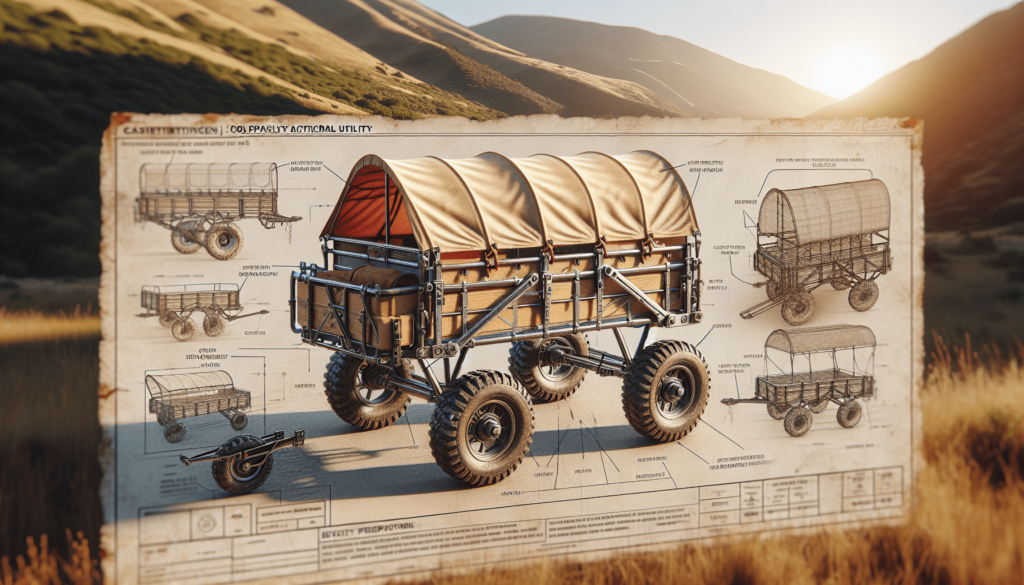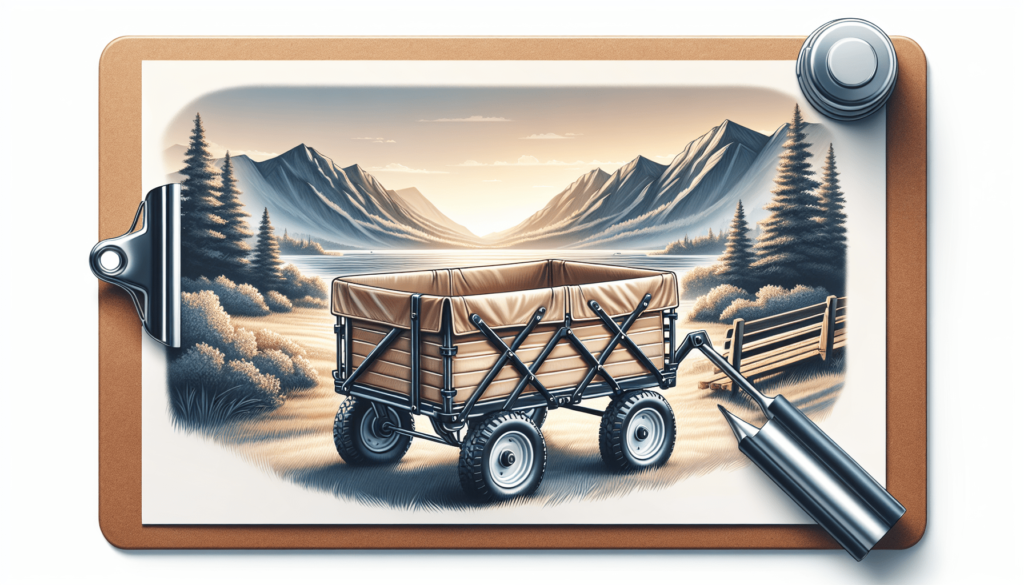Have you ever thought about what makes heavy-duty collapsible wagons so sturdy and reliable? These versatile tools have become a go-to for various outdoor activities, from picnics at the park to transporting gear for a weekend camping trip. Understanding the materials used in their construction can help you make an informed choice when selecting a wagon that suits your needs.
The Importance of Material Selection
When it comes to heavy-duty collapsible wagons, the choice of materials directly impacts their durability, weight capacity, and overall performance. Each component has been specifically chosen to enhance the wagon’s functionality, ease of use, and longevity. The combination of different materials ensures that your wagon can handle a wide range of tasks while remaining lightweight and portable.

Fabric: The Heart of Your Wagon
One of the most critical components of a collapsible wagon is its fabric. The material used must be durable yet lightweight to withstand various weather conditions and rough handling.
600D Polyester
One of the most common fabrics used in heavy-duty wagons is 600D polyester. This material strikes an excellent balance between durability and weight. The “D” stands for “Denier,” a unit of measurement that helps to gauge the strength of the fabric. 600D polyester is resistant to tearing, fading, and water, making it an excellent choice for outdoor use.
Canvas
Another popular option is canvas fabric. Known for its heavy-duty strength, canvas is a traditional choice that has been used for years in many outdoor applications. It offers excellent resistance to wear and tear. Although it can be heavier than polyester, its ability to withstand heavy loads can make it an ideal alternative for certain wagon designs.
Frame Material: The Backbone
The frame of a heavy-duty collapsible wagon is just as important as the fabric. A sturdy frame ensures that the wagon can support significant weight while maintaining stability during use.
Steel
Many heavy-duty wagons feature a frame made from steel due to its high strength and durability. Steel frames can easily hold several hundred pounds, making them suitable for transporting larger loads. However, steel can also be heavy, which could affect the overall portability of the wagon.
Aluminum
Opting for an aluminum frame can provide a lightweight alternative without sacrificing strength. Aluminum is naturally rust-resistant, adding to the longevity of your wagon. While it may not support quite as much weight as steel, it offers a perfect balance for those seeking a lighter option that remains highly durable.
Wheels: The Foundation for Mobility
Wheels are a crucial aspect of any collapsible wagon. The materials used in wheel construction will determine how well your wagon navigates various terrains.
Plastic Wheels
Most wagons come equipped with plastic wheels, which are lightweight and usually cost-effective. While they may suffice for smooth surfaces like grass or paved pathways, they might struggle with uneven or rough terrains.
Rubber Wheels
For more diverse terrain, consider wagons with rubber wheels. These wheels offer added grip and shock absorption, making them ideal for sandy beaches or rocky trails. Rubber wheels are also less likely to puncture than their plastic counterparts, providing your wagon with enhanced mobility and durability.

The Importance of Reinforcement
While individual materials are essential, the way they are combined can significantly affect the wagon’s overall strength and functionality.
Reinforced Seams
In many heavy-duty wagons, seams are often reinforced to prevent tearing or fraying, especially in areas that undergo high stress. Look for double-stitched seams, as they offer a greater level of durability than single-stitched ones.
Frame Supports
Some wagons add further support to the frame with crossbars or additional supports at stress points. These reinforcements help distribute weight evenly, reducing the risk of bending or breaking under heavy loads.
Additional Features: Enhancing Your Wagon
The materials used in heavy-duty collapsible wagons also extend beyond the fabric and frame. Various additional features can enhance your wagon’s overall usability.
Cup Holders and Storage Pockets
Cup holders and storage pockets enhance convenience, especially for family outings. These sections are often made from synthetic materials like nylon, which provide added durability.
Canopy Materials
If your wagon comes with a canopy, be aware that the materials can vary, usually including UV-resistant fabrics. These fabrics not only provide protection from sun exposure but also contribute to the wagon’s overall quality and longevity.
Weight Capacity: Understanding Limitations
When choosing a heavy-duty collapsible wagon, it’s crucial to pay attention to its weight capacity. This capacity is often dictated by the materials used in both the frame and fabric.
The weight capacity can range widely depending on these materials:
| Material Type | Estimated Weight Capacity |
|---|---|
| 600D Polyester + Steel Frame | 150-300 lbs |
| Canvas + Steel Frame | 250-400 lbs |
| 600D Polyester + Aluminum Frame | 150-250 lbs |
| Canvas + Aluminum Frame | 100-200 lbs |
Understanding these figures can help you choose the right wagon based on your expected usage.
Cost Considerations
The materials used in your collapsible wagon will play a significant role in its price. Higher-quality materials often equate to a higher cost, but they typically offer improved performance and longevity.
Budget-Friendly Options
If you’re on a budget, you might consider wagons made with plastic wheels and 600D polyester. These options can still provide decent durability for lighter loads and occasional use.
Premium Choices
For those seeking superior quality, you may want to invest in a wagon with an aluminum frame and rubber wheels, or one made from canvas. These options may have a higher initial cost, but their durability and functionality could save you money over time by reducing the need for frequent replacements.
Maintenance Tips for Longevity
Taking care of your heavy-duty collapsible wagon can extend its life significantly. Here are some tips to keep in mind:
Cleaning the Fabric
Regular cleaning helps maintain the fabric’s integrity. Use a mild soap solution and a soft brush to wash down the exterior. Always ensure that the wagon is completely dry before storing it, as moisture can lead to mold or mildew.
Inspecting the Frame
Periodically inspect the frame for signs of wear or damage. If you spot rust on a steel frame, consider treating it with rust protection spray to prolong its lifespan.
The Environmental Impact of Materials
In today’s world, being mindful of your wagon’s environmental impact is beneficial. While plastic and synthetic materials are prevalent, they can contribute to waste and pollution.
Eco-Friendly Options
Look for wagons created with recycled materials or those that emphasize sustainability in their manufacturing processes. Some brands focus on producing eco-conscious products that help minimize environmental impact, letting you haul your gear without leaving a heavy footprint.
Conclusion: Making the Right Choice
Understanding the materials used in heavy-duty collapsible wagons allows you to make an informed decision when purchasing one. Whether you prioritize weight capacity, durability, or environmental impact, being aware of these factors will guide you in choosing the right option that meets your needs.
Next time you find yourself in the market for a new wagon, you can take with you this knowledge of materials and their characteristics. You’ll be well-equipped to select a wagon that’s not only durable but also perfectly suited for your numerous adventures.

